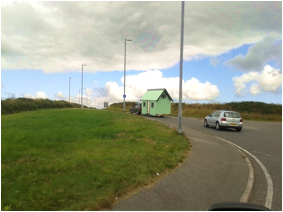The week of CAST Sundowner 2014, or, the way to make something distant become closer is not to move towards it but to make the distance conspicuous.
We visited the CAST building in Helston for a week in July 2014. Only a few months before, a part of the railway line we travelled along from London was reinstalled, in the Devon town of Dawlish, after it had been destroyed in the February storms. If we’d travelled a few months earlier, the journey might have taken about twelve hours rather than our, more typical, five. The national press coverage upon the railway’s reopening was an opportunity for Cornwall champions to remind the rest of the country that Cornwall was never that distant, in any case. Eden Project founder Tim Smit was quoted in The Daily Telegraph:
"Because we don't have, if you like, the levers of power to make us seem important enough, we get viewed by the capital as if it's still the old days of the Cornish Riviera … But actually it's a really thriving place. I mean, it's one of the hubs of the creative industries in Britain. Yet you wouldn't know that the way we're talked about."
The way to make something distant become closer is not to move towards it but to make the distance conspicuous.
‘CAST Sundowner’ was the title we decided upon as the collective name for everything that was to happen in the week. ‘We’ are nine of the twelve current associate artists of Open School East, the six-year-old son of one, and OSE’s two directors. I say ‘current’, but Open School East is an institution still in its first year. This first year began in September 2013, in a former library space in East London. OSE would allow twelve associate artists, their collaborators and people living in the local area and beyond, to pursue “artistic learning that is experimental, versatile and highly collaborative”. In truth, the year concluded with the associates’ group exhibition that opened a month after our visit to CAST but, as this excerpt from OSE’s website suggests, a week of living, working, eating and travelling together is better described as the culmination of a year spent learning how to work with, around and for others.
CAST has a network that extends throughout Cornwall, the South West, and to London and beyond. With this extended network, we gave our visit a skeleton structure in advance, composed of a series of events to anchor the week. The composition was collaborative, moored at points where our interests intersected with groups and individuals from the network: a stone sculptor completing a PhD about the granite quarry that is his place of work; a philosopher and publisher; an historian of ancient, sacred sites; the residents of Helston who were once schoolchildren and teachers in the CAST building; artists working from the building today; a ceramicist with 150 kilos of sand, woodchip and Cornish clay to make into a pizza oven.











